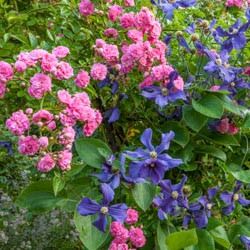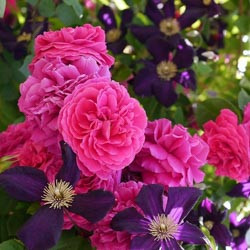Clematis and Roses Combinations, Best Climbing Roses, Best Clematis, Planting Roses and Clematis, Pruning Roses and Clematis
Climbing roses and clematis are perfect companions. They happily share the same arch, trellis, pergola, doorway, or garden wall, both reaching for the sun and providing a lush vertical floral display. They also have the same natural needs, require the same growing conditions (rich soil, moist, well-drained soils) and benefit from the same fertilizers. They often are of similar sizes, with the result that neither swamps the other.
They also complement one another. The clematis foliage can hide the rose’s bare legs. The roses add their lovely fragrance. And when combining their blooms, they often look many times more beautiful, making a much more dramatic impact than on a standalone basis.
You also benefit from this companionship in terms of floral display. If both roses and clematis bloom during the same period, you get twice the flower power and enrich the color palette of one single garden spot. If you select roses and clematis with different flowering periods, you will be extending their spectacular color show over a longer period. In both cases, you win!
However, before combining roses and clematis, you need to learn a few things, as not all clematis and roses work well together. Before pairing clematis and roses, learn about them.
 |
 |
 |
Both clematis and roses are available in a wide range of colors, making the color pairing possibilities almost endless. This is just a matter of taste.
| Plant Type | Perennials, Roses |
|---|---|
| Genus | Clematis, Rosa, Rosa - Climbing Rose, Rosa - Rambling Rose |
Tikya (Flickr)
| Plant Type | Perennials, Roses |
|---|---|
| Genus | Clematis, Rosa, Rosa - Climbing Rose, Rosa - Rambling Rose |
Create a membership account to save your garden designs and to view them on any device.
Becoming a contributing member of Gardenia is easy and can be done in just a few minutes. If you provide us with your name, email address and the payment of a modest $25 annual membership fee, you will become a full member, enabling you to design and save up to 25 of your garden design ideas.
Join now and start creating your dream garden!
Create a membership account to save your garden designs and to view them on any device.
Becoming a contributing member of Gardenia is easy and can be done in just a few minutes. If you provide us with your name, email address and the payment of a modest $25 annual membership fee, you will become a full member, enabling you to design and save up to 25 of your garden design ideas.
Join now and start creating your dream garden!